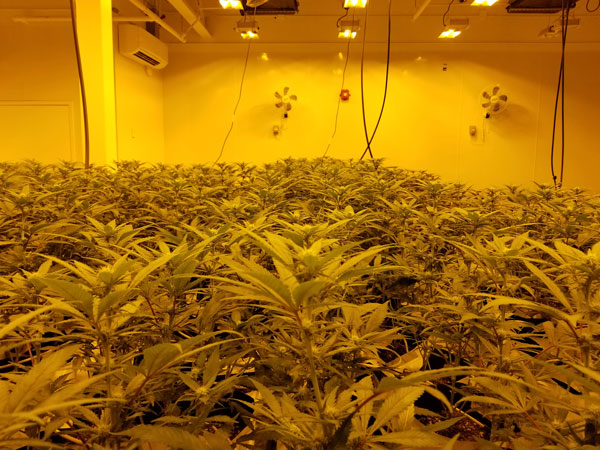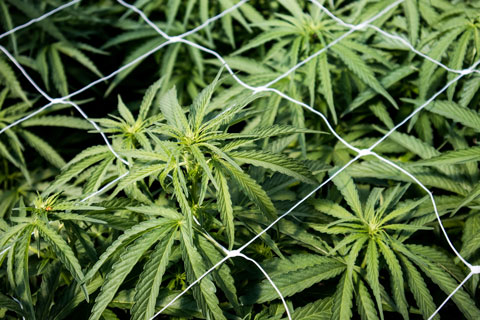8/1/2022
Growth & Flowering
Dr. Brian Corr

While not absolutely essential, it’s beneficial to grow the plants for some time after propagation under conditions that prevent initiation of flowers to allow plants to increase in size before flower initiation. If this vegetative growth stage is skipped, the plants will be very small when flowers initiate.
During the vegetative growth stage, plants are transplanted into larger containers and spaced as close as practical to conserve space. Photoperiod should be maintained with 18-hour days (or longer) and nights six hours (or shorter).
Pictured: Planting density in the flowering stage can range from less than 0.5 sq. ft. per plant to over 5 sq. ft. per plant (two to 30 plants per sq. m).
During the vegetative growth stage, the grower determines the ultimate growth habit. Cannabis plants can be grown pinched to induce multiple flowering branches or grown unpinched, resulting in one dominant flowering stem and smaller lateral flowering branches. If pinched, the plants require three to five weeks of vegetative growth before moving to an environment to initiate flowers. If unpinched, this time can be reduced to two or four weeks.
The amount of time in the vegetative phase largely determines the ultimate size of the plant. For a production strategy of growing large plants, spaced far apart, more time is required in the vegetative stage. Other growers prefer growing smaller plants, spaced closer together, which allows for a shorter time in the vegetative stage.
Initiating flowering
Most cannabis will initiate flowers when the daylength is below a critical duration (technically, the length of the night is longer than a critical duration). The critical daylength varies by cultivar/strain. Most growers use a 12-hour day/12-hour night for cannabis flowering, although some cultivars will flower with days as long as 14 hours (nights as short as 10 hours) or perhaps even longer. If the critical daylength is known, total biomass yield will be greatest if the daylength is as long as possible while still allowing flowering, although the total yield of cannabinoids may not increase.
Some cultivars have the greatest yield of cannabinoids when grown with a 12/12 photoperiod, while others may yield more with longer daylengths. For convenience, most growers use the 12-hour day/night schedule. Some strains will initiate flowers and continue to initiate new flowers under a 13-hour day, but stop initiating flowers at 12 hours.
Controlling photoperiod is relatively easy for cannabis grown in a fully enclosed warehouse—the lights are on for 12 hours, then off for 12 hours. In a closed warehouse, there’s no difficulty maintaining darkness during the night phase.
For greenhouse-grown cannabis, the dark period is created by pulling blackout cloth over the crop during times of year when the outdoor daylength exceeds 12 hours. Cannabis is especially sensitive to light leaks during the night period, much more so than other photoperiodic crops like poinsettia and chrysanthemum. For this reason, blackout cloth must be properly maintained to avoid light leaks. Light can also leak into the growing area from fan shrouds, around doors and so on, so pay close attention to these areas.
Growers should check for light leaks often. Interruption of the dark period by light leaks is associated with the development of hermaphrodite plants—male flowers on an otherwise female plant.
Hermaphroditism has also been reported when “safe lights” are used during the dark period. Safe lights are green lights reported to not interfere with photoperiod. It appears these lights may be acceptable for short periods of time at low light intensities, but can induce hermaphrodites on some cultivars if used for an extended time or with too great an intensity.
Most cannabis cultivars require support to keep the stems from falling over before harvest. While some growers use bamboo sticks or tomato cages, the easiest approach is to use the same support netting used to support cut flowers. These nets typically have 6 × 6 in. (15 × 15 cm) openings. Tall cultivars may require two layers or more of netting. Stem elongation is fastest for the first two or three weeks in flowering and typically stops after three or four weeks. The support net should be installed as soon as the plants are placed in the flowering area.
 Pictured: The easiest approach to supporting cannabis stems is to use the same support netting used for cut flowers. These nets typically have 6 × 6 in. (15 × 15 cm) openings.
Pictured: The easiest approach to supporting cannabis stems is to use the same support netting used for cut flowers. These nets typically have 6 × 6 in. (15 × 15 cm) openings.
Planting density in the flowering stage can range from less than 0.5 sq. ft. per plant to over 5 sq. ft. per plant (two to 30 plants per sq. meter). Many things determine the planting density. In some jurisdictions, licensed producers are limited in the number of plants that may be present at a given time. If mother stock plants are considered part of the plant count, there’s an incentive to have fewer mother stock plants and therefore fewer cuttings are available. So the incentive is to produce as great a yield per plant as possible. Large plants require greater spacing between plants, but also require more time in the vegetative phase.
If there’s no limit to the number of plants allowed, most growers prefer a shorter crop time with less space per plant, even though this requires more mother stock plants to produce the required number of cuttings. Closer spacing requires less time in vegetative phase.
The above information is applicable to cannabis cultivars that flower in response to daylength. Breeders have developed cannabis cultivars that don’t respond to daylength, but instead flower after a certain number of days have passed after germination. These are referred to as autoflowering cultivars. Because autoflowering cannabis will flower regardless of photoperiod, there’s no reliable way to maintain mother stock plants. Therefore, autoflowering cannabis is grown from seed. After germination, plants are transplanted into a larger container, then grown to harvest.
At the time of this publication, autoflowering cultivars are more commonly used where environmental control isn’t possible, while traditional cultivars are used in warehouse and greenhouse production. However, the plant-to-plant variability of autoflowering plants is often high. Yield and cannabinoid content of autoflower cultivars are typically not as great as vegetatively propagated cultivars. Breeders are rapidly improving these traits. As quality improves, autoflowering cultivars likely will be used more widely.
Whether autoflowering or traditional, crop time is determined by the cultivar. Some cultivars will be mature and ready for harvest eight weeks or less after beginning the flowering phase, while others may require as long as 12 weeks. It’s important to measure yield considering useable harvest weight by space by time. If only eight-week cultivars are grown, a flowering area can produce 6.5 crops per year, in comparison to only 4.3 crops per year if each crop takes 12 weeks.
Yield of dried flower and trim varies by growing method and cultivar, but with standard conditions it’s reasonable to yield 0.1 lb per sq. ft. of plant canopy per crop (500 grams per sq. m). IG
Want to Read the Full Chapter?
Would you like to have the full chapter on hand for reference? Go to https://www.ipgbook.com/ball-publishing--bpu--publisher-BPU.php to purchase the new 19th Edition Ball RedBook. The cannabis chapter is in Volume 2, which breaks down cultural information by crop. Volume 1 also has great information on greenhouse structures, equipment and technology, including a chapter on controlled environment agriculture.